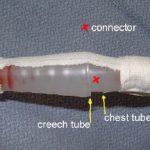Bleeding is a well-recognized complication of severe pelvic fracture. Certain fracture patterns, usually with significant involvement of the posterior portions of the ring, are associated with significant bleeding. Most of these fractures are unstable to some degree.
Stable pelvic fractures (those that do not require internal or external fixation) are not generally prone to a large amount of bleeding. However, it can occur on occasion, and surgeons at the Massachusetts General Hospital have devised a simple prediction system so patients more likely to bleed can be identified and monitored more closely.
They retrospectively looked at their stable pelvic fracture population over 5+ years. A total of 391 patients with stable pelvic injury were identified. Of those, 280 never required transfusion and 111 did. Of the latter, only 15 bled from their stable pelvic fractures.
The authors found the following three significant indicators of bleeding from stable pelvic fractures:
- Admission hematocrit < 30%
- Pelvic hematoma on CT
- Any systolic blood pressure < 90 mm Hg
Bottom line: This is a simple, retrospective study with low numbers. However, the three indicators commonly indicate significant early bleeding in any trauma patient, so it makes sense to apply it here, too. If a patient meets one or two criteria, consider monitoring in the ICU and consider angiography. If all three or met, strongly consider appropriate intervention (angiography if good blood pressures can be maintained, or fixation and/or preperitoneal packing if not).
Reference: Predictors of bleeding from stable pelvic fractures. Arch Surg 146(4):407-411, 2010.



